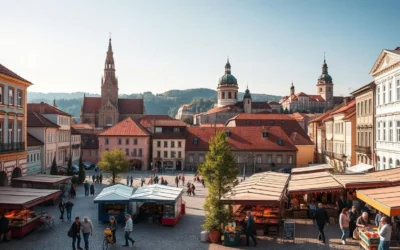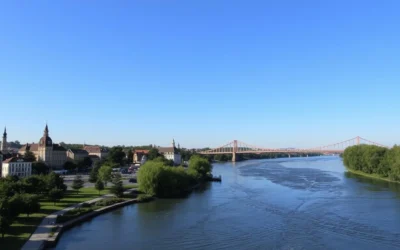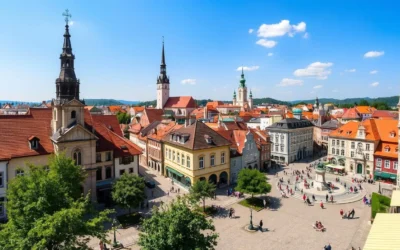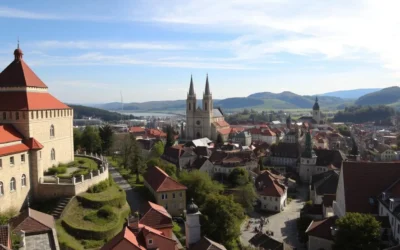Surprising fact: this protected floodplain supports one of Europe’s richest bird concentrations, with tens of thousands of waterbirds gathering at key wetlands each year.
If you’re planning a trip from the United States, this guide gives a clear, short roadmap for a nature-rich escape in central europe. You’ll learn which sights matter and which activities fit a long weekend or a week-long stay.
Expect curated ideas like narrow-gauge rides through Gemenc Forest, boat trips on Drava oxbows, and world-class birding at Lake Riha and the Cormorant Forest. We also note nearby culture: Villány wine slopes and the Mediterranean-feel city of Pécs.
Quick wins: simple planning tips, map pointers, and where to base yourself so your visit focuses on wildlife, hiking, photography, or local food without endless fuss.
Why you’ll love Danube-Drava: a floodplain world of forests, rivers, and rare wildlife
A living floodplain unwraps here: rivers, woodlands, and wetlands stitched into a compact, changeable landscape. You can move from shaded forests to open marsh in minutes, watching how water shapes habitat and wildlife.
The area protects a mix of climate zones—humid river corridors, Mediterranean‑tinged slopes, and drier eastern plains. That meeting of climates creates a variety of habitats in a surprisingly small world, so each walk feels different.
The Gemenc Forest is the heart: wide floodplain tracks, braided channels, and oxbow lakes nurture deer, boar, and raptors. Lake Riha hosts large heronries and hunting eagles, so bring binoculars and time to linger.
Because much of this region is within protected areas, you’ll often find solitude and excellent photo ops. Rivers define the experience—follow them and the landscape opens into marshes and meadows alive with birds.

- Seasonal drama: high waters and low flats shift views and wildlife.
- Intimate variety: multiple habitats packed into a small area.
- Quiet access: protected areas give pockets of solitude for nature lovers.
Top outdoor picks in Danube-Drava National Park, Hungary: Best Things to Do – Top Picks
Choose from short train-and-trail days in the floodplain, sun-drenched limestone walks, and focused birding sessions at key wetlands.
Hike the Gemenc floodplain by narrow‑gauge train and trail
Hike the Gemenc Forest floodplain by narrow‑gauge train and trail
Start in Gemenc with a narrow‑gauge ride that drops you deeper into the floodplain. Then follow marked hiking trails that hug oxbows and channels.
You’ll move slowly and notice water birds, deer tracks, and changing light along the route.
Birdwatch at Lake Riha
Birdwatch at Lake Riha: herons, egrets, storks, and raptors
Bring optics for this prime birding spots. Lake Riha hosts Purple Heron, Little Egret, Night Heron, and raptors like White‑tailed Eagle.
Sunrise and dusk are the best windows for activity and photography.
Seasonal wildlife and hill walks
Spot record Red Deer and other forest fauna in season
Time your visit for the early fall rut to hear and sometimes see Red Deer at dawn or dusk. Local hides and guided walks improve sightings.
Walk the sunny limestone slopes of the Villányi Mountains
The Villányi limestone slopes offer warm microclimates and Mediterranean plants—an easy contrast to the shaded forest trails.
Mix in cave‑visiting and easy nature walks near gateways
Pair short cave visits with family‑friendly loops near park entrances for varied, low‑effort days outdoors.
- Pace over distance: elevation is low, so you can focus on wildlife and photos.
- Base strategically: pick a place near trailheads to catch sunrise and sunset sessions.

| Activity | Best time | What to bring | Why it matters |
|---|---|---|---|
| Narrow‑gauge + trails | Spring–Fall | Binoculars, water, map | Access deep floodplain habitat with minimal hiking |
| Lake Riha birding | Migration & breeding seasons | Long lens, scope | Large heron colonies and raptor watches |
| Villányi limestone walks | Late spring–early autumn | Sun hat, sturdy shoes | Warm slopes and Mediterranean flora contrast |
Wetland and river adventures: Drava days, oxbow lakes, and the “Hungarian Sea”
Calm, shallow channels invite easy paddling and boat trips that thread into the Cormorant Forest and nearby lakes. Guided canoe or small boat outings let you slip into intact oxbow lakes where cormorants, herons, and kingfishers gather.
Try a guided route if you’re new to local waterways. Guides know safe channels and the best inlets for wildlife viewing. Ask about current river levels before you plan a paddle day.

- Glide the Drava by paddle or boat to reach quiet oxbow lakes and reed edges for effortless wildlife sightings.
- Plan for Kis‑Balaton — hides, boardwalks, and buffalo reserves protect wet meadows alive with waders during migration.
- Expand with Lake Balaton, also known as the “Hungarian Sea” — the largest lake in Central Europe for easy shoreline birding and scenic ferries to Tihany.
Bring dry bags, a simple bird list, and safety gear (PFDs, sun protection). Pack your shuttle plan so your boat day ends near your car or pickup point. With patient, slow travel you’ll get the best wetland photos and memories.
Cultural side trips you can pair with nature time
Mix quiet wildlife days with short city escapes that reveal layers of art, faith, and winemaking. These nearby towns make easy half‑day or full‑day detours from the trails.
Stroll Mediterranean‑feeling Pécs: cathedral, mosque, and museums
You can spend a day in Pécs touring the cathedral and the 16th‑century mosque of Pasha Qasim. Pause in galleries that trace Roman, Ottoman, and Austro‑Hungarian history across the city.
Toast Szekszárd and the Villány wine region
Sip bold reds on warm slopes. Tasting rooms and cellar doors pair local wine with regional dishes and vineyard views.
Explore Siklós’ award‑winning old town and castle ambience
Wander cobbled lanes and historic buildings around Siklós castle. The town’s churches and small squares feel like living history.
Cross Lake Balaton by ferry to Tihany
From either shore you can ferry to Tihany, visit the 11th‑century abbey, climb the geyser‑cone, and circle quiet lakes that are great for birding.

- Add Keszthely for Festetics Castle and museum time.
- These places pair well with spa stops and easy drives between nature spots.
| Place | Highlight | Ideal for |
|---|---|---|
| Pécs | Cathedral, Mosque, museums | Art, history, a relaxed city day |
| Villány / Szekszárd | Vineyards, tasting rooms | Wine tastings and vineyard views |
| Tihany (via Lake Balaton) | 11th‑century abbey, lakes | Birding and short hikes |
Where to stay and how to get around
Pick a base near the river or forest and you’ll cut daily travel time and catch dawn wildlife with ease.
Simple cabins, family‑run hotels, and regulated campsites sit close to the main habitats. Book ahead in peak months—rustic riverside rooms and camping spots are limited and sell out fast.

Comfortable stays near the woods and water
Choose lodging by activity: one night near Gemenc for hikes and deer watching; another along the Drava for boat days and wetland birding.
Parking, public transport, and access tips
Use maps to find small parking areas by trailheads and put‑ins. Many lots are tiny—arrive early and bring cash for fees and nearby cafés.
Public transport fills gaps: narrow‑gauge trains, regional buses, and Balaton ferries link towns and trail access. If you plan to paddle, arrange shuttles between put‑ins and take‑outs and confirm water levels with outfitters.
| Stay type | Why choose | Practical tip |
|---|---|---|
| Cabins / hotels | Comfort after long days | Book early near activity hubs |
| Camping / campsites | Close to nature, flexible | Reserve and pack cash |
| Town base (Pécs / Villány) | Culture, food, wine | Drive or use public transport for day trips |
Plan your trip by clustering overnights by activity, downloading offline maps, and keeping a simple checklist for parking, permits, and shuttle details.
Plan your visit: maps, seasons, and essential facts
Map-led planning saves time and makes each day count. Use detailed maps to link narrow‑gauge stops, Lake Riha hides, and Drava access points so you spend more time outside and less time backtracking.
Use detailed maps to target trails and birding spots
Download and carry park maps that show trailheads, hides, and put‑ins. Pin Gemenc narrow‑gauge stops and the Lake Riha hides before you leave so you can move efficiently between sites.
Best time to go: seasons and activity windows
Spring brings strong migrations and active courtship. Early fall is prime for the Red Deer rut and dramatic dawns. Summer favors water activities and ferry hops on Lake Balaton for calmer paddling and long light.

Know before you visit: habitats, climate zones, and rules
The area spans humid river corridors, Mediterranean slopes, and drier plains. Expect quick micro‑climate swings—pack layers and sun protection.
These protected areas have rules: stick to marked routes, respect bird‑sensitive zones, and check local facts boards or trip reports for closures or high water updates.
- Plan efficient days: link a morning hide at Lake Riha with an afternoon forest loop.
- Check conditions: verify water levels and ferry timetables for Lake Balaton activities.
- Choose city bases: mark Pécs and Keszthely on your map to mix culture and nature without long drives.
| Season | Highlight | Tip |
|---|---|---|
| Spring | Bird migrations | Bring optics and expect active hides |
| Summer | Water activities & Lake Balaton ferries | Book flexible paddling days for calm winds |
| Early fall | Red Deer rut | Use guided walks and dawn hides for best sightings |
Conclusion
Choose two or three priorities—hiking trails, boat days, or birding—and build each day around them.
In this compact national park area you’ll move from quiet forests to oxbow lakes and the Cormorant Forest. Plan time for a lake morning, a river paddle, and an afternoon town stroll for contrast.
Use maps and seasonal facts to pick the best time: spring migrations or the fall Red Deer peak. Lock in cabins, campsites, or hotels early and note parking, trailheads, and put‑ins for smooth travel.
With easy access to nearby cities, wine towns, and century‑old buildings, your trip mixes nature, history, and relaxed touring. You’ll leave loving this landscape and ready to return.
The above is subject to change.
Check back often to TRAVEL.COM for the latest travel tips and deals.






